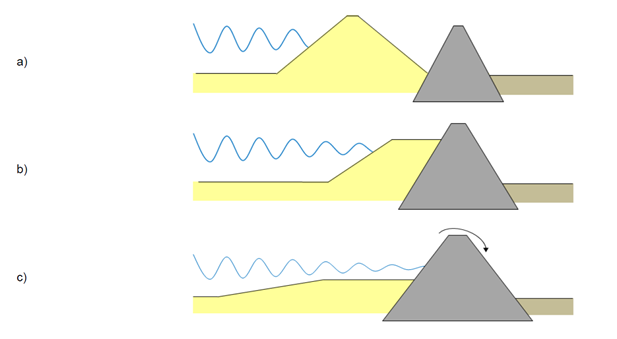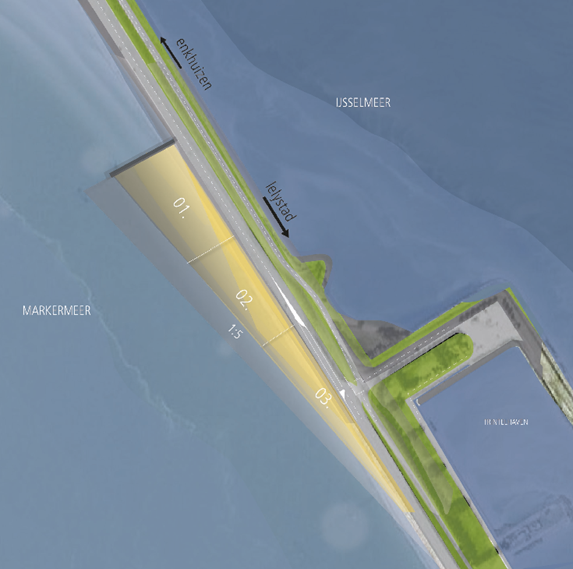Planning and design
The Houtrib Dike was an already existing (grey) dike system before the pilot project started. Therefore, it was decided to design a hybrid combination of a foreshore with a dike. Different types of hybrid flood defense systems exist. The three main ones are the stand alone sandy solution (a), strength from combination sand and dyke (b) and the foreshore that functions as a buffer decreasing the forces (wave attack) on the dike (c). In the planning and design of the Houtrib Dike pilot project the full strength of both the dike and the sandy foreshore were taken into account. Therefore, type (a) would only be chosen if the dike was in a bad condition (Hondsbossche Dunes). The idea behind type (a) is that if the sandy solution would be eroded the dike fails as well. At type (c) the profile of the foreshore first changes shape before the forces of water and waves can attack the dike. For the Pilot Houtrib Dike a combination of the three types was chosen.

To make sure that the foreshore was strong enough the focus in the design was on the necessary volume of sand above a certain height (closure depth). To define the strength of the design sedimenttransportformulas and morphological processmodels were necessary. It was important to also take subsidence into account which may lower the foreshore over time and decrease the volume of sand in the profile. With subsidence we mean the lowering of the ground because of the weight of the foreshore on top of it and the consolidation of the applied sand.
| Length | 450 m |
| Width | 150 m |
| Sand volume | 70.000 m³ |
The figure below presents the top view of the design of the pilot. A sheet pile wall is installed perpendicular to the existing Houtrib dike to create an enclosure for the sand in longshore direction. A stable orientation of the triangular section is chosen to prevent systematic longshore transport and realignment of the stretch. Due to the triangular design, the different sections can be viewed as different types of sandy foreshore defenses. During a storm, the wider section will behave like a standalone sandy foreshore defense (type b) whereas the smaller section will behave more like a hybrid solution in conjunction with the existing dike (type c).

The role of vegetation
Vegetation plays a vital role in the success of sandy foreshore solutions. Different reasons are identified. Vegetation can contribute to stabilizing a sand body (i.e. to prevent erosion and sand loss) (Thiel de Vries et al., 2016). Furthermore, vegetation around the water line can contribute to wave attenuation, thereby increasing the safety of the design or enabling a reduction in foreshore width or volume. Lastly, vegetation generally has a positive impact on the aesthetics of the design.
In the pilot, specific attention was given to the ‘vegetation design’. An optimal combination of species, subsoil conditions and location on the section were researched to arrive at the most effective way to develop vegetation on a sandy foreshore. The aim was to create a stable vegetation layer that was able to prevent erosion. The construction of the vegetation patches is done partly by planting and sowing and partly by placing wooden matts with reed plants near the water line.
